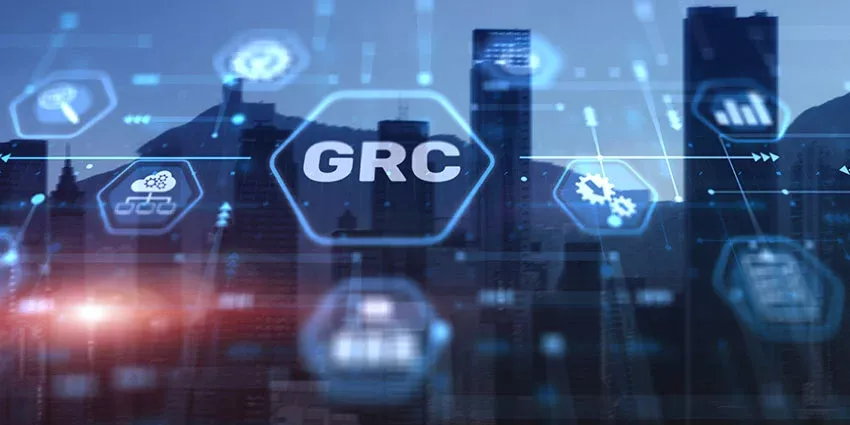The Case for an Integrated Approach to GRC in the Modern Enterprise
- GRC
- 07 August 24

Introduction
Chances are that you’re already managing governance, risk, and compliance (GRC) in some way or the other. But if your approach is ad hoc and siloed – i.e., if your risks, compliance, and audits are managed on separate systems with different taxonomies and no way to collaborate or exchange data – then, it might be time for a change.
Why? Because in today’s dynamic world, success hinges on one’s ability to make informed decisions quickly based on data collected and validated across the organization. Stakeholders need to know which risks to tackle on priority, how those risks influence other enterprise risks, which business objectives could be impacted, what issues could arise, and whether the controls in place are truly effective.
Meanwhile, internal audit – the third and final line of defense – needs to focus on assurance, rather than re-evaluating assessments completed by the second line. To do that, they need real-time visibility into events, issues, actions, and assessment outcomes.
An integrated GRC program provides all these insights. So, teams can take informed steps to protect the business and capitalize on the opportunities that really matter.
Why Don’t More Organizations Adopt an Integrated Approach?
In our experience, many businesses already have separate programs, objectives, and budgets for each GRC function – be it risk management, compliance, or internal audits. Having operated like this for years, businesses are either resistant to change or lack the drive to ensure integrated GRC data and reporting. Some companies are swayed by the bells and whistles that point solutions can provide, even if those tools work in silos, disconnected from other GRC functions.
There’s no doubt that making the shift to integrated GRC does take time and effort. But the rewards are well worth it. Imagine being able to predict risks and opportunities faster, collaborate seamlessly across functions, and make informed decisions quickly – all in a streamlined and cost-efficient manner. That’s what integrated GRC can enable.
Integrated GRC Is More Important Now Than Ever
All around us, risks are changing at a rapid rate. Four years ago, the top global risks were largely environmental – extreme weather, climate action failure, natural disasters, and biodiversity loss. This year, the top 5 risks have expanded to include AI-generated misinformation, societal/ political polarization, the cost of living crisis, and cyberattacks.
Compliance requirements are also evolving. In the first half of 2024 alone, Europe approved the corporate sustainability due diligence directive as well as the AI Act. In July, California’s Workplace Violence Prevention Plan (WVPP) came into force, as did Australia’s Environmentally Sustainable Procurement Policy.
As these regulations and risks keep changing, so also do business processes, objectives, employees, technologies, and third parties.
None of these changes occur in isolation. They’re all interconnected. For example, when you onboard a new vendor, their risks become your risks. A data breach in their networks could weaken your own cybersecurity posture, which, in turn, could lead to compliance violations, operational disruptions, reputational damage, and more.
Integrated GRC enables you to see all these interconnections. Data from spreadsheets, point solutions, and other sources are unified into a single GRC view. This helps you predict risks with accuracy, ensure consistent compliance, and strengthen your resilience.
Benefits of an Integrated GRC Program
Our customers and prospects across industries tell us that these are some of the benefits they’ve experienced with an integrated approach to GRC:
Faster, more accurate risk insights through a common GRC taxonomy
When departments such as risk management and compliance work in silos, they end up developing separate terminologies and frameworks to describe similar GRC concepts. This creates a lot of confusion when you’re trying to aggregate and report GRC data.
By contrast, an integrated GRC approach focuses on unifying and standardizing GRC taxonomies across the enterprise. So, all departments and stakeholders are on the same page, speaking the same language. This minimizes misunderstandings and miscommunications. It also simplifies the process of gathering and analyzing GRC data from across business units. There are fewer discrepancies and ambiguities in the data because everyone is using the same terminologies.
The end result is that management gains a clearer picture of the organization’s GRC posture, which, in turn, strengthens decision-making.
Improved cost-efficiencies, zero duplication of effort
When your GRC approach isn’t coordinated, multiple departments could end up assessing the same risk, or testing the same control. This duplicates effort, wastes resources, and increases costs.
An integrated GRC approach eliminates these inefficiencies by streamlining GRC workflows across departments. Tasks and responsibilities are clearly defined to minimize overlaps or redundancies.
Meanwhile, GRC data is collected, stored, and accessed centrally – so teams don’t have to waste time hunting for information. The data produced by one department can even be reused by another. For example, compliance reports can be reused in risk assessments and internal audits. This reduces labor costs, and frees up GRC resources for more strategic activities.
Stronger collaboration across business lines
In an integrated GRC program, various business lines work together in harmony. Risk managers, compliance teams, internal auditors, and others have a clear understanding of how their activities intersect with those of other lines.
Through an integrated GRC platform, information on risks, losses, controls, and metrics is easily shared across departments. Each business line is able to provide valuable inputs and support to the other. The first line’s observations and assessments of risks and compliance flow to the second line which then ensures that risks and controls are effectively managed.
Subsequent business lines, such as internal auditors and the management team, can also collaborate and monitor risks easily through the same GRC platform. This synchronized approach enhances the organization’s resilience and ability to achieve business objectives.
A comprehensive view of GRC through integrations with other systems
GRC doesn’t exist in a vacuum. It needs to be able to exchange data with other business systems like enterprise resource planning (ERP) platforms, security tools, and threat and vulnerability scanners. External content also matters – be it regulatory updates, third-party risk ratings, or data on environmental, social, and governance (ESG) factors. All these inputs enrich your ability to monitor risks, regulations, and their impact on your enterprise.
An integrated GRC approach helps you aggregate all this data by connecting your GRC platform to multiple systems within and outside the enterprise. APIs enable the seamless flow of data across these touchpoints. For example, with MetricStream products, you can automatically pull in vendor security ratings for third-party security assessments or regulatory changes and updates from CUBE. These insights make your GRC program more robust and effective.
A Fast-Growing Regional Banking Giant Enhances Business Decision-Making with MetricStream
We recently contracted with a regional bank that was a rising superstar in the BFS industry. Evaluation began with the Internal Audit team searching to replace its archaic point solution with its latest variant, while Operational Risk Management, Information Security, and Compliance Groups looked to automate their manual processes. Legacy systems, manual processes, and data silos were hampering risk visibility and effective reporting to regulators. Moreover, only 60% of planned risk assessments were executed on time and Internal Audit continued testing all risks and controls already validated by the second line.
As the evaluation progressed on separate tracks, the Internal Audit team realized the benefit of real-time visibility into first- and second-line data and incidents/events during audit planning or fieldwork. In their own calculations, there were significant time-cost-resource optimizations with such seamless enterprise data visibility. Hence, began a joint evaluation for a single and enterprise GRC platform.
After a year of rigorous evaluation wherein the criteria also included built-in practices relevant for banking industry, track record in managing and deploying enterprise programs, and a team who would guide them through their journey with the application, they chose MetricStream.
With the implementation:
- Operational risk management processes have been streamlined for optimal efficiency. Meanwhile, a centralized risk and control library saves time on risk assessments and control tests.
- The Internal Audit team reaps the benefit of a more efficient program allowing better audit planning and execution, and avoiding redundancy of assessment due to complete visibility into first and second line assessments, observations and actions. This allows them to focus on critical areas and data analysis.
- Compliance Group and Information Security have imbibed the embedded practices and tailored their specific use cases using the low-code, no-code toolkit.
The bank’s multi-dimensional organization structure (MDOS) has been mapped on MetricStream, making it easier to aggregate risks at any level of the organization. With better visibility into risks and controls, the bank is able to make more informed and agile decisions that strengthen business success.
Improve Your Agility, Performance, and Resilience with MetricStream ConnectedGRC
MetricStream ConnectedGRC enables an integrated approach to GRC with seamless collaboration across risk, compliance, audit, cybersecurity, and sustainability teams. Through MetricStream, you can effectively identify, assess, and manage all your risks and compliance requirements on one platform. Designed with advanced analytics and AI capabilities, ConnectedGRC delivers best practices to meet the evolving needs of today’s dynamic enterprises.
- Gain a single source of truth to manage, assess, and track GRC across the enterprise
- Break down the silos between business lines, enabling a coordinated approach to GRC
- Standardize GRC taxonomies, and simplify risk data aggregation from across departments
- Get a unified and real-time view of the relationships between risks, controls, regulations, policies, business objectives, cybersecurity, sustainability, and other data elements
- Streamline GRC processes, minimizing redundancies and inefficiencie
To learn how MetricStream can help you accelerate your GRC journey, request a personalized demo today!








